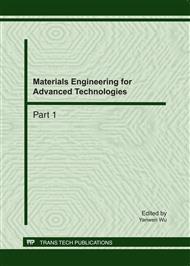p.1318
p.1324
p.1329
p.1335
p.1341
p.1346
p.1352
p.1358
p.1362
Analysis of Biomedical Prospect of Leaves from Liriodendron Chinense (Hemsl.) Sarg by GC/MS
Abstract:
Liriodendron chinense (Hemsl.) Sarg (Chinese tulip tree) has a long history of utilization and plantation, but the chemical components of benzene/ethanol extractives of Liriodendron chinense (Hemsl.) Sarg leaves were unrevealed. The analytical result by method of GC/MS showed that the chemical components of benzene/ethanol extractives of freeze-dried Liriodendron chinense were identified as 55 constituent, and the main components are as: 2-Propenenitrile, 2-chloro- (13.75%), 1-Mercapto-2-heptadecanon (13.10 %), 1-Mercapto-2-heptadecanon (12.77%), Ethanol, 2-butoxy- (12.03%), 1-Docosanol (10.74%), Guanidine, (4-aminobutyl)- (5.05%), 5,10-Pentadecadiyn-1-ol, acetate (4.82%), 1,2,4-Butanetriol (3.13%), Thiophene, 2-ethyltetrahydro- (2.09%), 1-Eicosanol (2.00%), 1-Butanol, 3-methyl-, formate (1.60%), Butanoic acid (1.60%), .alpha.-D-Xylofuranoside, methyl 3,5-di-O-methyl- (1.30%), Phenol, 2,6-dimethoxy-4-(2-propenyl)- (1.29%),5.alpha.-Pregnane-12,20-dione (1.12%), Cyclopentanol (0.82%), etc. As the first report here, our result by GC/MS showed that the benzene-methanol extractive of freeze-dried leaves from Liriodendron chinense (Hemsl.) Sarg can be developed into top value-added materials of medicines and spicery.
Info:
Periodical:
Pages:
1341-1345
Citation:
Online since:
June 2011
Authors:
Price:
Сopyright:
© 2011 Trans Tech Publications Ltd. All Rights Reserved
Share:
Citation:


